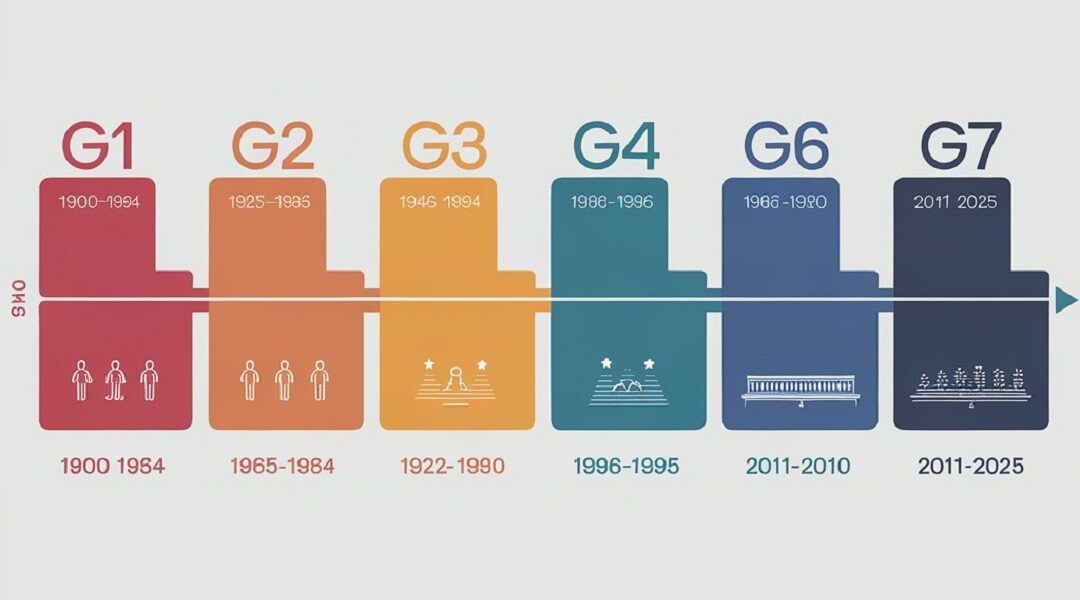Generations are groups of people who were born during the same period, lived through the same historical events and received similar cultural influences. The Baby Boomer Generation , Generation X and Generation Y or Millennials are some of the best known.
For each generation, a start and end date is established that delimits the period to which it belongs. The years vary depending on the author, so these dates are indicative:
| Generation | Period of birth |
|---|---|
| Baby Boomer | 1946-1960 |
| Generation X | 1961-1979 |
| Generation Y or Millennial | 1980-1994 |
| Generation Z or Centennial | 1995-2010 |
| Generation Alpha | 2011-undefined |
Baby Boomer Generation
The name of this generation is associated with the increase in birth rates experienced after the end of World War II in some countries. This group includes people born after 1945, the year the conflict ended, and around the 1960s.
They are the generation that experienced social and cultural transformations. This period began with the signing of the Universal Declaration of Human Rights. Other revolutionary and liberation movements took place, such as the Hippie movement and its protests against the Vietnam War.
People who belong to this generation are characterized by their high dedication to work and their persevering spirit.
Generation X
It is the generation established between 1961 and 1979, a period during which events such as the space race between the United States and the Soviet Union, the dissolution of The Beatles and the birth of Microsoft took place.
They are considered more independent than the previous generation, due to the possibility that both parents worked outside the home or were divorced.
This independence and their nonconformist nature led them to devote greater effort to their academic training. They are a better prepared group, compared to the Baby Boomers.
Generation Y or Millennial
Millennials are those born between 1980 and 1994. These years saw events such as the Chernobyl nuclear disaster, the end of the Cold War and the Persian Gulf War.
Animated series such as The Simpsons and Dragon Ball were created. Video games became increasingly popular, giving rise to some as famous as Tetris and Pac-Man.
Those born in this generation are individuals who are already accustomed to technology, mainly consoles and computers. They have a greater capacity to communicate with authority figures, such as parents or bosses. Their education is based on respect and tolerance, and they defend cultural diversity, teamwork and respect for the environment.
Generation Z or Centennial
It began in 1995 and lasted until 2010. Some of the most relevant events of the period were the attacks of September 11, 2001 in New York, the introduction of the euro in the countries of the Eurozone and the Conclave that elected Pope Benedict XVI.
People belonging to this generation have grown up in a technological world, so mobile devices and the Internet are part of their daily lives. They are aware of the need to have a good academic record, although their time is marked by job insecurity. Concerned about climate change, they have greater ecological sensitivity.
Generation Alpha
The start year is set for 2011, although the end date has not yet been set. Some notable events in this period are the departure of the United Kingdom from the European Union, the intensification of climate change and the final throes of the 2008 economic crisis.
Those born in this time period are still too young to define their profile. They are in the midst of the digital age, the age of information and immediacy. It is this same immediacy that will make them more consumerist than previous generations. They are also likely to be more committed when it comes to issues of social equality and ecological culture.
Non-contemporary generations
| Generation | Period of birth |
|---|---|
| Lost generation | 1883-1900 |
| Greatest Generation | 1901-1927 |
| Silent generation | 1928-1945 |
Lost generation
Located between 1883 and 1900, a period in which there were great scientific advances such as the discovery of X-rays. Upon reaching adulthood, those born in this generation were witnesses and combatants in the First World War.
The general feeling of confusion that prevailed at that time gave rise to the name of this generation.
Greatest Generation
Defined between 1901 and 1927, a period marked by the First World War, by catastrophes such as the earthquake that hit San Francisco in 1906 or the sinking of the Titanic in 1912. During the 1920s, an economic recovery took place that brought prosperity to certain countries, such as the United States.
Those belonging to this group lived a youth marked by economic changes and the rise of nationalism in Europe. For this reason, this generation that lived through the period between the two wars is considered the most resilient of all.
Born between 1928 and 1945, a turbulent period marked by the 1929 Crash and the Second World War, both events pushed members of this generation to lead a sober life without excesses.
The main features of this group are austerity, conformity and submission, hence they are called the silent generation.
Conclusion
In summary, the concept of “generations per year” highlights the rapid pace of change in society, technology, and culture. Understanding how different generations are defined and how frequently new ones emerge can provide valuable insights into social dynamics and trends. This awareness aids in fostering intergenerational dialogue and collaboration, which is essential for addressing contemporary challenges and creating a cohesive future.
FOR FERDUR INFORNATION VISIT:https://proteomics.uk/




